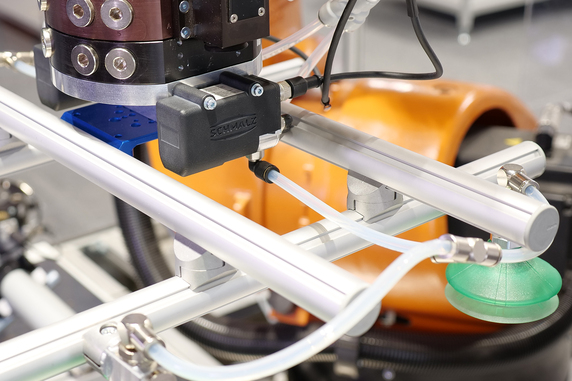
Automation is both a blessing and a curse: it ensures competitiveness and eases personnel bottlenecks. However, the increasing use of robots also increases energy requirements and thus the product carbon footprint. Schmalz is therefore focusing on resource-efficient product life cycles and designing new systems for sustainable vacuum automation.

© International Federation of Robotics
After two years of decline, more industrial robots entered service in Europe for the first time in 2021. As reported by the International Federation of Robotics (IFR) in June 2022, the level last year was actually higher than the 2018 high, at around 78,000 units. Demand had risen particularly in the metal and machinery (+50 percent) and plastics and chemical products (+30 percent) sectors. The automotive industry, on the other hand, did not record any growth, but remained at its high level of 19,300 installations.
The renewed growth is a positive sign for robot and component manufacturers, but the EU’s Green Deal is putting them under pressure: The call for climate neutrality is challenging developers of automation solutions to combine the digital with the green transformation.
To ensure that the widespread use of digital technologies does not inevitably lead to a steady increase in energy consumption, electronic waste and the ecological footprint, it is important to keep an eye on the product life cycle – from design to recycling.
“We have to distinguish the CO2 package with which we send our product to the customer from the emissions that occur during use,” demands Dr. Maik Fiedler, head of the Vacuum Automation and Vacuum Handling business units at J. Schmalz GmbH. To keep the pack as small as possible, Schmalz relies on short procurement routes – 50 percent of suppliers come from its own state – electricity from renewable sources and a sustainable distribution system.
“We avoid energy-intensive materials and production processes as early as the development stage. As a result, we save material and the customer consumes less energy in later operation,” says Fiedler, citing a procedure that has been practiced at Schmalz for years. Now the vacuum expert is writing the next chapter and developing systems that are completely independent of compressed air.

© Schmalz
Performance on a par with pneumatic solutions
This sounds like a simple solution, but there are hurdles to overcome. One of these is the higher power density of pneumatic vacuum generators. “We are developing new system concepts that intelligently combine purely electrical components. As a result, we achieve cycle times that are comparable with powerful pneumatic vacuum generators, including active blow-off,” explains Fiedler.
The efficient concept consists of a centrally installed electric vacuum pump on one side, an intermediate accumulator, and valves mounted close to the suction pad on the other side. “Our storage facility is the hoses in which we pretension the vacuum so that it can be called up as needed. This leads to a significant reduction in the evacuation time. By using several valves, we can install diverse independent suction circuits,” explains the vacuum expert.
When presenting the all-electric solution, which is on par with pneumatic systems, Fiedler has the new LQE aeration valve in mind. It is mounted directly on the gripper and reduces the actual volume to be evacuated by pre-tensioning. This allows for quick ventilation. “We are talking here, depending on the system, about times of less than 50 milliseconds. The secret behind this is the large cross-section, which realizes flows of over 300 liters per minute,” Fiedler emphasizes. The all-electric actuator control of the 3/2-way vacuum valve contributes to the higher energy efficiency of the overall system. Schmalz has also integrated a sensor – it monitors and controls the vacuum and the process directly at the gripper. “This is how we reconcile sustainability with digital transformation,” says Fiedler.
The heart of the compressed air-free vacuum automation system is a powerful vacuum generator: the Compact Pump GCPi. It weighs around three kilograms and is so compact that it can also be used on lightweight robots. In combination with a battery – a 24-volt supply is all it needs – it is ready for mobile applications with autonomous transport systems (AGV) and robots (AMR). “The new Compact Pump is significantly cheaper to operate than a comparable ejector even after a short duty cycle,” Fiedler emphasizes.

© Schmalz
There are several ways
This concept follows Schmalz’s efficiency strategy, whose products focus on the more effective use of energy. Pneumatic vacuum generators such as the RECB remain part of the portfolio. They achieve high vacuum values and volume flows in relation to the installation space, are robust and can use existing compressed air lines.
Schmalz continuously optimizes the pneumatic vacuum generators with regard to their energy efficiency. But there are other aspects that make automation sustainable: For one thing, it is a question of service life and how easy it is to replace wearing parts or separate and recycle the various materials. On the other hand, digitalization provides support with condition monitoring and predictive maintenance. Users thus keep an eye on the process and the vacuum components used, among other things. In addition, digital twins speed up commissioning and realistically simulate the subsequent process. “Digitization gives us many tools to uncover and eliminate energy guzzlers,” says Fiedler.
Web:
www.schmalz.com



